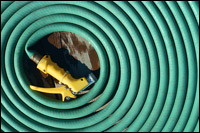Dear Umbra,
I’m diligently avoiding PVC plastics, but cannot find a good quality non-PVC garden hose. We have particularly high water pressure, so we need a hose that can withstand the pressure. I only need to water the veggie garden a couple of times a week in summer, but it’s not quite feasible to do it with a watering can. To further complicate matters for you, we live in New Zealand, though we are willing to try importing a non-PVC hose if such a thing exists.
Judi
Wellington, New Zealand
Dearest Judi,
I’d like to personally accompany a garden hose over to Wellington on your behalf. But that might be more than you want to spend.

Stream of consciousness.
© Corbis.
When it comes to hoses, rubber is our no-vinyl-that’s-final stand-in for PVC. Rubber hoses are heavier than vinyl ones, and renowned for durability. They are often available in areas with active farming. In the U.S., we have at least two name brands available: Craftsman, by Sears, and Gilmour. I bet your local garden store or agricultural-supply shop will be able to help you out.
Just a brief segue about rubber: natural rubber is made from milky latex sap; synthetic rubber is made from oil products. The vulcanization process that makes this magical substance more durable (and also soft and unsticky) also makes it resistant to reprocessing — it can’t simply be melted down and reborn like glass, for instance. But most old rubber is tires, which can be cut up into ingenious new products, ground up or turned into “crumbs” for use in playgrounds and asphalt, chemically treated and included as filler in new rubber products, or even burned for fuel in factories (a trend that concerns some fans of clean air). Here in the U.S., we’re getting better at making use of our millions of scrap tires: in 1990, 11 percent were recycled; by 2003, that number had grown to 80 percent.
Old tires (or tyres, if you prefer) play a part in my next piece of advice. If you don’t irrigate, I heartily recommend doing so, with a second kind of rubber hose: a “drip” (or soaker) model. These recycled (yes! old tires!) hoses are perforated, and release droplets into the soil without drenching the foliage. Surface drip irrigation is much more efficient than overhead watering, and preferred by most veg plants. Simply lay one in and among your plants (you can cover it with a few inches of compost, soil, or mulch if you like). When the watering moment arrives — the wee hours if you have an irrigation timer, otherwise the morning or evening, to avoid wasteful evaporation — you will hook up your garden hose to the drip hose, turn the faucet a quarter turn, and rejoice. I even found a New Zealand source for you (not a product endorsement, mind you, but see the nice picture).
Here in the Northern Hemisphere we are heading into winter, but I hope this advice will reach you in time to be useful Down Under.
Coily,
Umbra

